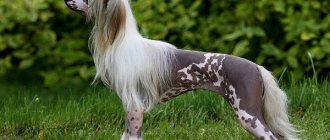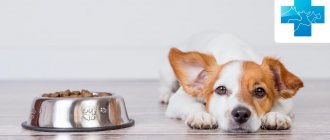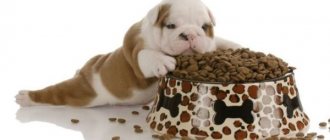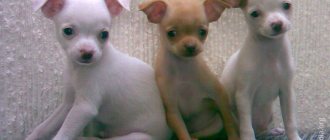Changing a pet’s diet may be dictated by medical necessity or simple everyday circumstances. But in both cases, you need to know how to switch a dog to another dry food without unpleasant consequences for it . It is better to do this extremely delicately so as not to harm the health of your four-legged friend and not make him nervous due to the loss of his usual food.
How to switch a dog to another dry food
Why switch your dog to another food?
The decision to change the diet can be made either independently by an experienced and attentive dog breeder, or by a veterinarian.
The main reasons when there is a need to switch to another dry food are most often:
- suspicions of allergies, as evidenced by constant scratching and skin problems;
- excess or underweight (subject to optimal portion sizes and normal physical activity);
- loss of shine of the coat, its slight loss;
- lethargy, lack of interest in games, long walks;
- diarrhea and vomiting, constantly or at regular intervals, occurring shortly after feeding;
- features of physiology: age, illness.
If you doubt your knowledge of nutrition, contact your veterinarian to create a menu
If you are thinking about how to properly create a nutrition plan when switching your dog to dry food, it is best to do it as directed and under the supervision of a veterinarian. The doctor will be able to identify the reasons for the pet’s problems. He will recommend the most optimal type of food, which, depending on the pet’s condition and its problem, can be natural, canned or dry.
Water consumption rate
The daily rate of water consumption depends on the type of diet. The dog receives enough water from natural feeding, so the daily intake is calculated based on the ratio of 50 ml per 1 kg of weight. When feeding mainly canned food, the dog also receives enough moisture, but the food contains preservatives, so the daily water intake is calculated at the ratio of 75–100 ml of water per 1 kg of weight.
A diet of dry food implies a minimum water content in food, so the daily water intake is calculated from the ratio of 125–150 ml of water per 1 kg of body weight.
It is extremely important to provide your pet with unhindered access to water and ensure that he drinks after each meal.
Transferring a dog from one type of food to another
The assertions that natural food is preferable to dry food are a thing of the past. Of course, nothing can replace a piece of beef tenderloin or a sugar bone. But no one canceled them. A good owner, even with dry feeding, periodically arranges a holiday for his pet, pampering him with fresh meat or an appetizing bone.
Switching to dry food does not entail a complete abandonment of other products
When deciding to change your diet, you need to adhere to the following rules:
- gradualism, which should last from one to two weeks;
- persistence if the animal categorically refuses unfamiliar food;
- The most important thing in how to accustom your pet to dry food is to make the right choice of a new product: this can be provided by a recommendation from a veterinarian or by independent painstaking study of all the features of different brands of dry food and canned food, calculating the nutritional value and vitamin-mineral composition of a natural diet.
Changing food requires gradual adaptation and should not be done at once.
The most common situation is transferring an animal from one dry food to another. It is advisable to “stretch” this process for at least a week. The table below shows a diet change scheme that is quite easy for the owner and gentle for the four-legged friend.
Table 1. Dog feeding plan when changing food
| Period/days | Old food | New food |
| 1st and 2nd | 75% | 25% |
| 3rd and 4th | 50% | 50% |
| 5th and 6th | 25% | 75% |
| 7th and subsequent | 0% | 100% |
Having measured out the daily amount of old and new “drying”, it must be mixed well and divided into two parts - for morning and evening feeding. This must be done every day. And starting from the 7th, you can safely switch to a new brand.
Only after a week will the dog be ready to finally give up the old diet
It is possible to conclude that the food is suitable for the dog no earlier than one and a half to two months from the moment it was introduced into the diet. If during this time there is no negative reaction to the new food, it means that it is absorbed by the body and does not harm it.
Video - Transferring the dog to a new dry food
Possible consequences and problems
Replacing your usual dishes is always a big stress for the body. Most often it is expressed either through digestive disorders or through a four-legged hunger strike.
Stool upset or nausea
The need to reconstruct the pancreas has already been mentioned above. In addition, a lower level of stomach acidity, i.e. pH, is required for easy digestion. Changes take about 7-10 days, and until then, diarrhea, constipation and vomiting are completely normal.
It is worth sounding the alarm only in 2 cases: when symptoms persist for more than 10-14 days or when the frequency of their occurrence increases. Remember that frequent bouts of vomiting and uncontrolled diarrhea can lead to severe dehydration and even death.
Refusal of new products
Getting used to it takes time, so don’t be afraid of refusing food offered in the first days. The most effective way to fight is an instructive hunger strike. The recommended limit for adult animals is 2-3 days, and for puppies - only 1 day.
REFERENCE!
The most important picky animals are representatives of small breeds. Finding dishes that suit them can only be done through trial and error.
The second recommendation is mandatory soaking of dry granules. This not only accustoms the dog to softer food, but also to new tastes, and also eliminates tricky food selection.
What food should I switch my dog to?
The answer to this question depends on several circumstances:
- will the budget support the regular purchase of industrial food or can you save money by daily offering your dog food cooked from inexpensive offal and trimmings;
- do owners have enough time to regularly purchase food and then prepare dog soup or porridge;
- how the dog’s body reacts to different types of food: if something is categorically unsuitable, causing negative reactions, this food will have to be abandoned.
The optimal feeding scheme for a pet depends on its health and the wealth of its owner.
By the way, these same criteria should be used when thinking about how to choose food for a dog when the puppy turns into an adult and its diet must undergo changes in both volume and quality.
Each type of nutrition has its pros and cons.
Dry food
Very convenient to use. It contains the entire necessary set of nutrients, vitamins and microelements. You can choose a brand intended for healthy dogs of different breeds and ages. There are special brands of products for pets with health problems.
When choosing dry food, it is not recommended to settle on budget options
It has a long shelf life, allowing you to keep it at room temperature without worrying about special containers - “drying” retains its properties well even in an unpacked paper bag. Thanks to this, you can purchase in large quantities or bags.
This is a waste-free product - if there is uneaten food left in the bowl, it will not spoil and can be safely given at the next meal. Among the disadvantages is the price. The better the food, the higher its cost. Premium class products are not available to every dog owner. If you are introducing your pet to dry food for the first time, then on our portal you can find recommendations and tips on this topic.
Premium food is able to provide the pet’s body with a set of all necessary substances
Canned food
Sold in portioned bags or in jars. Good for feeding four-legged dwarf breeds, when the dog can easily handle a miniature jar or the contents of the bag in one sitting. This is a well-balanced product that takes into account the needs of the breed.
This type of food is not very convenient for feeding dogs of medium and large breeds: large cans weigh quite a lot. When purchasing a large batch, you will have to resolve the issue of transportation.
The main disadvantage of canned food is its strong specific smell.
If the dog has not finished the contents of the jar, you need to take measures to preserve the leftovers - close them tightly and put them in a cold place so that they do not spoil. Often food from large cans has an unpleasant odor, which can irritate family members when feeding a pet in the kitchen of a small apartment.
Natural food
Typically these include thick soups or porridges with meat, which are cooked in a large saucepan for a day or two. Among the advantages is confidence in the freshness of the product, the safety and benefits of its ingredients.
Natural nutrition should take into account the characteristics of the dog’s body so as not to lead to complications
Please keep in mind that natural foods take a long time to prepare. In addition, even the most well-mannered dogs of medium and large breeds splash it when eating liquid food. Therefore, if feeding occurs at home, after each feeding it is necessary to wet clean the place where the pet has just eaten.
You must always remember that the nutritional plan must be thought out based on the balance of substances in the feed. To do this, you need to study the needs of your pet depending on its age and breed.
Pros and cons of a natural diet
The natural diet menu is quite similar, so you don’t need to be a culinary genius to prepare it. This type of feeding has the following advantages:
- prevention of dental and oral diseases, based on a constant combination of soft and hard foods;
- absence of dangerous ingredients, because it is you who control the quality of products and the composition of dishes;
- easy digestion due to the natural origin of food;
- the ability to adjust the menu to suit any therapeutic diet.
There are also disadvantages. These include the need for daily food preparation and the difficulty of complying with the norms of KBZHU (calories-proteins-fats-carbohydrates). This forces you to spend a considerable part of your personal time and buy additional vitamin complexes.
Abrupt transitions from one food to another
Jumping between food can play a cruel joke on the owner and his four-legged friend. The forums are full of sad stories about the painful consequences the pets of those owners who constantly experiment, ignoring the advice of veterinarians, have had to go through.
Sudden changes in diet can end up ruining your dog's digestion.
While eating the same food, the pancreas is “tuned” to produce a certain type of enzyme. A sudden change in food, which will include previously unavailable ingredients, can have a devastating impact on this sensitive organ and the health of the pet as a whole.
Special attention is required for older (adult and old) dogs that have known only one type and brand of food for a long time. They need to be more carefully transferred to a different diet and monitored by their owners for their reaction to the new food.
Mature and older dogs tend to have a hard time making dietary changes.
Negative symptoms manifest themselves as:
- Redness and itching of the ears;
- Regular loose stools;
- Allergic reactions, which at best begin to appear immediately, at worst - allergens accumulate in the body and literally fall on the poor animal after 1-2 months in the form of a painful rash. The rash, consisting of blisters with wet contents, covers the entire body, including the pads of the paws. The bubbles burst, then dry out, the skin in their places becomes covered with scabs, which fall off along with the fur.
Areas on the dog's body affected by an allergic rash are marked in red.
In such situations, you need to consult a specialist.
The proof is in the chair!
The best way to monitor your dog's digestive health is to pay attention to the quality of their stool. While minor changes in stool color and consistency are normal, any major changes may indicate a problem that needs to be addressed. A great way to evaluate your dog's stool is to use a fecal evaluation chart. The ideal stool score is 3–4. Lower numbers may indicate dehydration or constipation, while higher numbers indicate gastrointestinal distress, which can be caused by a variety of factors. If your dog's stools are consistently outside the normal range, it is recommended that you consult your veterinarian about the health of your dog's digestive system.
© shutterstock
Dog's reaction to new food
During the period of diet change, you need to monitor:
- how a new product is absorbed by the body;
- whether it causes unwanted reactions;
- Did your pet like it?
The first two points are important and are usually followed by dog owners. But the owners have different attitudes towards the third. Often owners show strong persistence, forcing the dog to “love” new food.
If you see that your dog is reluctant to eat new food, listen to his needs.
Such persistence is absolutely justified in two cases:
- When the diet changes in the direction of its improvement, for example, from cheap dry or canned food to expensive food. The dog may not be particularly enthusiastic about the unusual contents of the bowl. There are explanations for this: cheap food often contains strong artificial flavors and taste enhancers. While the natural components of expensive food are less pronounced. In such a situation, you should show strength of character and the goal will be achieved;
- When a change of food is recommended by a veterinarian and is intended to improve the pet’s health. In this case, the owner’s persistence will be directed exclusively for the benefit of the animal.
Reluctance to get used to a new food is often due to the lack of flavorings in it
But not all owners are able to resist the whims of their pet and sometimes follow his lead when the dog makes it clear that he liked the old food better. This category of owners can simply get acquainted with the recommendations of professionals on how to properly switch from one food to another. And the problem will be solved.
When a new food is well accepted by the body and benefits the dog, he demonstrates:
- excellent health;
- magnificent appearance - shiny coat, clean ears and eyes;
- willingness to play, walk, follow the owner’s commands;
- If the norm is observed, the weight will be stable.
A pet satisfied with its food is less prone to diseases and vitamin deficiency
If the rules for switching to another food are not followed, the pet’s body may malfunction, which is often caused by a lack of vitamins. You can recognize a lack of a particular substance by the dog’s behavior. We will tell you more about the connection between the animal’s well-being and the lack of vitamins in its body below.
Signs of vitamin deficiency in a dog
How to choose
Each dog has an individuality, with its own tastes and problems, but fortunately, today, there is a huge selection of food that can suit any picky dog.
Food from the common table is contraindicated for the dog. When choosing food for an animal, you should focus on industrially produced diets.
It is worth remembering that high-quality and specialized food is difficult to find in regular stores, but if you succeed, you are lucky. And if not, don’t worry, usually there are more individual options in pet stores or veterinary clinics; in any case, you can order the food you need in a store or have it delivered to your home from the Internet.
Quality puppy food is hard to find in stores
Second point. Watch for the presence of various dyes and carcinogens in the composition.
Third, consider your pet’s age, activity level and individual characteristics (for example, dry food for sterilized ones). Discuss the diet change with your veterinarian and look for reviews online.
Do you need vitamins and supplements?
It is impossible to get everything you need from regular food, therefore, in addition to standard foods, you should add the following main sources of natural vitamins to your diet:
- raw seaweed;
- wheat germ flour;
- fish fat;
- ground egg shells;
- Brewer's yeast.
To avoid vitamin deficiency, all animals eating natural foods should be tested for essential vitamins. If deficiencies are identified, the veterinarian may recommend ready-made vitamin and mineral complexes in tablet form.
Drink plenty of fluids 24/7
Providing your pet with round-the-clock access to fresh, clean water is the first and main rule when using ready-made dry diets. If wet food and natural meat consist of 60–80% water, then in dry granules it is practically absent. A lack of fluid in the diet negatively affects the functioning of all body systems and can lead to dehydration and the development of chronic diseases.
To avoid problems, regularly check the availability of water in your animal. Many dogs refuse cloudy drinks that have previously been contaminated with saliva. And they do the right thing: in such an environment, pathogenic microbes quickly multiply, causing illness and poisoning. Therefore, if you are concerned about your dog’s health, do not be lazy to update the contents of the drinking bowl more often.
Working owners who spend the whole day outside the home are advised to pay attention to automatic waterers - special devices designed to give the dog water without human intervention. They come in two main types:
- with the supply of water from a previously prepared reservoir;
- with connection directly to the water supply system.
Often such gadgets are equipped with filters for water purification, the ability to regulate pressure and other additional functions.











